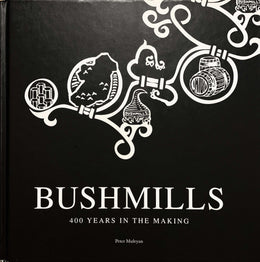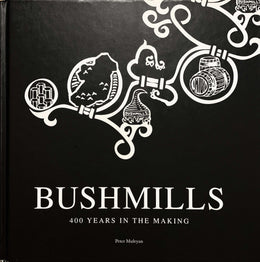IN 1821 THE VILLAGE of Port Ellen was founded by Walter Frederick Campbell, Laird of Islay.

Port Ellen Distillery as it was in 1935.
Built around Loch Leodamais, Port Ellen had the advantage of a sheltered deep water harbour (which is still in use today as the main seaport for Islay). Development of the village in this ideal spot was rapid and in 1824-25 Port Ellen Distillery was built for Alexander Ker Mackay, with the support of Walter Campbell the Laird. Like many distilleries Port Ellen was developed on the site of a mill. The ground lease was held by Alexander MacKay but the buildings were leased to Major James Adair. The development of the distillery had undoubtedly been encouraged by the Excise Act of 1823 which had reduced the duty on spirits from an exorbitant level to the more equitable 2s. 3d. per gallon. One aim of the Act was to discourage illicit distilling and in this it was at least partly successful. The Act enforced the introduction of the spirit safe in distilleries, a glass-sided cabinet through which it was possible to see and test the strength of the spirit during the distillation process without actually having access to the spirit. The use of the spirit safe was only to be enforced after tests had been made to ensure that it had no harmful effect on the quality of the whisky. These historic, official experiments were carried out at Port Ellen in 1824. Another set of historic experiments were carried out in Port Ellen Distillery around this time by Robert Stein and Aeneas Coffey who were carrying out research that would culminate in the invention of the "Patent Still" (patented by Stein in 1826). The " Patent" or " Coffey" still is a continuous distillation system which is still used today to produce grain whisky in Scotland and all over the world. A pier was built in the village of Port Ellen in 1826 which helped with the transport of materials to and from the distillery. The pier became a focus for the village of Port Ellen which developed around it and eventually overtook Bowmore as the island's port.

Alexander Ker Mackay, the distillery founder was involved in bankruptcy proceedings within months of starting up. His position was handed on, in rapid succession, to three relatives, none of whom made a success of the business. Eventually in 1832, Ebenezer Ramsay, who was the member of the family in charge of its distilling interests sent his nephew, John Ramsay to Islay to give his opinion on the viability of the distillery. It was a mark of John's ability that he was only 18 at the time. On arrival in Islay, John found that his cousin, John Morrison (who had sub let the Port Ellen distillery buildings from Major Adair) thought that the distillery was unworkable. John Ramsay, however, felt that the distillery had a bright future in the right hands and reported this to Ebenezer. John Ramsay was then allowed to set up in partnership with his cousins John and Thomas Morrison to run the distillery. John Ramsay first went to Alloa to be trained as a distiller by James Morrison, another brother of John and Thomas. He then returned to Port Ellen where the partnership paid him a salary of £150 per annum to run the distillery. Port Ellen distillery prospered and, in 1839 a second whisky warehouse was added to the site.
In 1840, Major Adair died and the buildings lease became vacant. The lease was auctioned off and John Ramsay, keen to put his interests on a firmer footing, entered a bid. Unfortunately his offer was not the highest, however, Walter Campbell, the Laird of Islay had such confidence in Ramsay that he used the Laird's right, to match the winning bid and secure the lease on Ramsay's behalf for £1,950. John Ramsay's businesses prospered and it was not long before he was able to re-pay the Laird. A stock take in 1842 revealed that the distillery warehouses contained 7399 gallons of whisky worth £1479.16s. In 1848 John Ramsay was instrumental in lifting restrictions against exporting casks of more than 80 gallons in capacity and in gaining the right to store whisky duty free under bond. Port Ellen warehouse No 1 is reputed to be the first duty free whisky warehouse in the United Kingdom (it was used latterly as part of the cask filling area). During John Ramsay's tenure of the distillery it was extensively altered and enlarged with a significant proportion of this work being carried out in the early 1860s. Around this time Ramsay's Glasgow office was run by a W P Lowrie, whose name would reappear more than once in the continuing story of Port Ellen Distillery. However, in 1869 Lowrie left to set up on his own as W. P Lowrie and Company Ltd, whisky blenders. He was moderately successful and came up with several innovations including being the first to pre-treat casks when sherry butts became scarce in the late 1800s.
John Ramsay (1814-92) was a dynamic man of many interests and above all he was an innovator. He became one of the pioneers of the export trade in Scotch whisky to the United States. John Ramsay's interests were not limited to whisky, he was an importer of sherry and madeira in Glasgow, inaugurated the first bi-weekly cargo and passenger service by steamship between Islay and Glasgow, was chairman of the Glasgow Chamber of Commerce, was elected Liberal MP for Stirling in 1868 and for. Falkirk from 1874 to 1886, received the freedom of Linlithgow for parliamentary services and earned the gratitude of Islay for enlarging and improving the pier at Port Ellen in 1881.

When he died he owned all of the parish of Kildalton and Oa, had built houses for himself at Carnmore and Kildalton and had done much to improve the standard of farming on the island. The distillery was carried on under the ownership of Mrs Ramsay until her death in 1906 when the estate passed to her son, Captain Iain Ramsay of Kildalton (1875-1959). It was lain who built the Ramsay Hall in Port Ellen in memory of his father. From the time of the restrictions on the whisky industry during the Great War to the introduction of Prohibition in the USA, the business was struggling to survive. Captain Ramsay sold the property and the assets in 1920 to the Port Ellen Distillery Co. Ltd., and on the liquidation of that company the assets transferred to the company set up by the Glasgow office employee, W. P Lowrie and Company Ltd, now owned by James Buchanan & Co. and John Dewar & Sons Ltd., both of which merged with The Distillers Company Limited, of Edinburgh, in 1925. (Neil Wilson's book "Scotch and Water" contains further reading on the history of Port Ellen Distillery.)
The distillery was one of many which closed down in the economic depression of 1930. In that year, all malt whisky distilleries owned by companies in The Distillers Company Limited were transferred to the ownership of its subsidiary, Scottish Malt Distillers Ltd. Port Ellen Distillery was used as a makings and bonded warehouse for the next thirty six years. Then" : as part of a programme to ensure adequate supplies of the distinctive Islay whiskies to meet the needs of its blending companies, The Distillers Company Limited decided to bring Port Ellen Distillery back into production.
Written by John A Thomson
The text is an excerpt from "Port Ellen: Distillery and Maltings" (pp. 2 - 6), written by John A Thomson, published 2010 by Diageo Plc.







